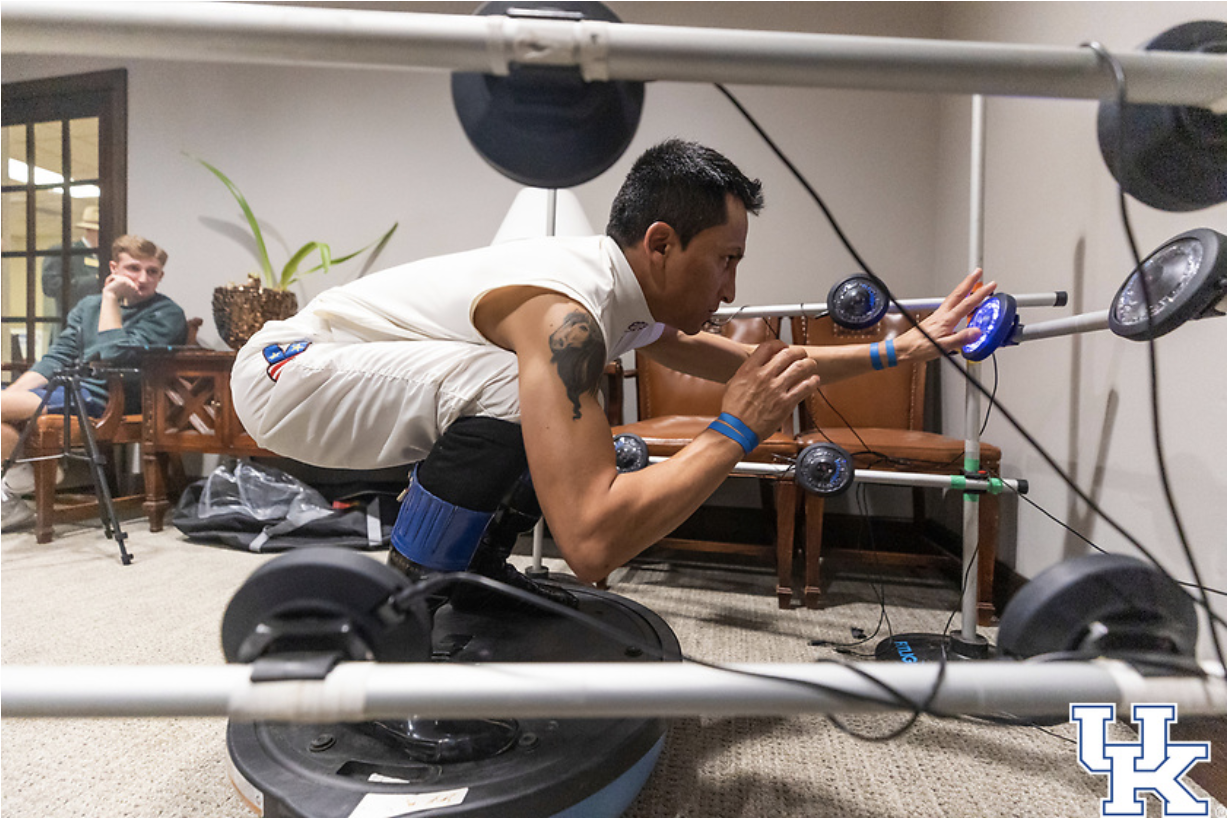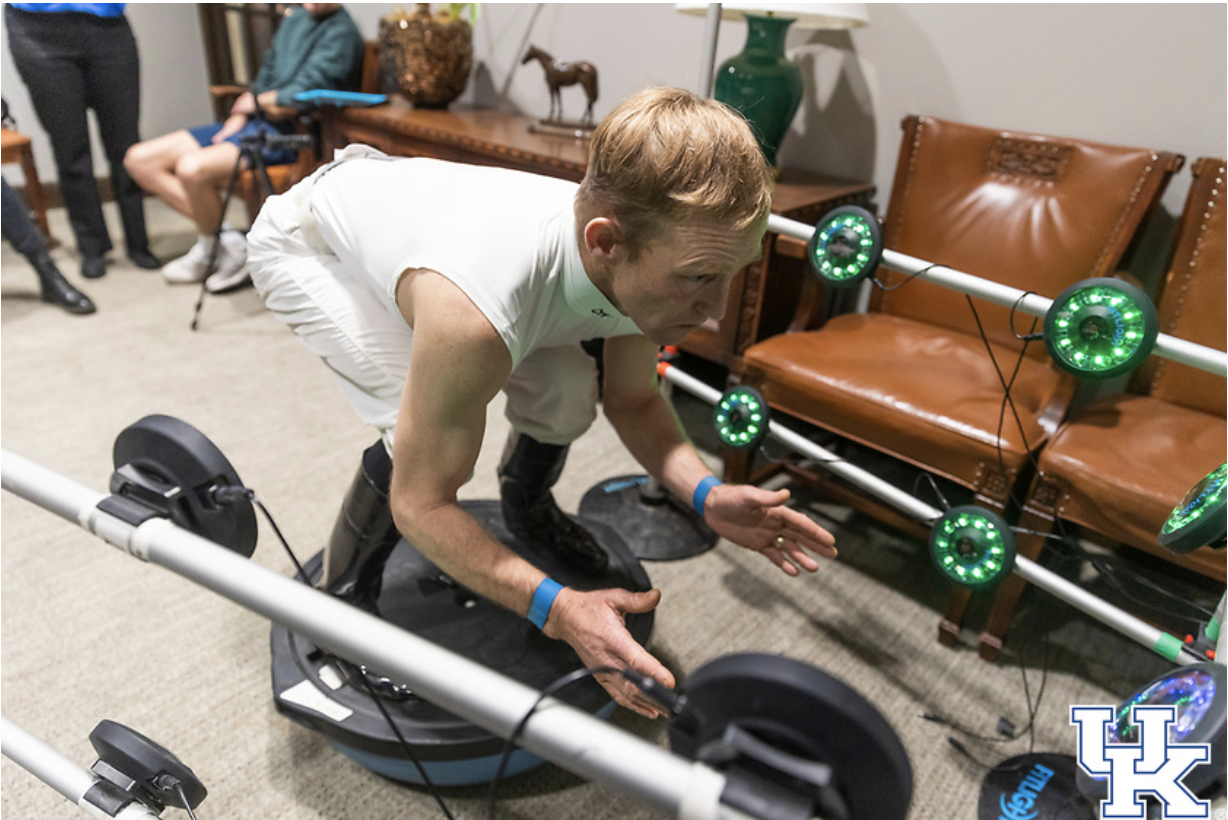
The Graham Test
Jockey Rafael Bejarano using The Graham Test Dynavision II Board at Keeneland Racetrack. Arden Barnes | UK Photo.
Michaela Keener, PhD Candidate — University of Kentucky, College of Health Sciences
Under the beaming sun, the Keeneland racetrack in Lexington buzzed with excitement on race day. Amidst the bluegrass hills, tradition and anticipation merged, promising a thrilling day of Thoroughbred racing. Jockeys are lining up at their posts eagerly waiting for the first race bell to ring.
Jockeys live for the thrill of horse racing, but the dangers are constant. They often compete in multiple races per day, sometimes back-to-back. Many also work horses in morning exercise sessions. Being a jockey is a high-risk job, and injured riders face a dilemma of taking time off to recover, as non-riding days mean no pay since they are independent contractors.
In some situations, jockeys conceal injuries or ride through pain until they reach a breaking point. Head injuries, especially concussions, require careful management, and returning to the saddle too soon can have dire consequences if another fall happens. Some concussion symptoms may not appear for up to 48 hours after the concussion has occurred.
“The idea of The Graham Test assessment is to give personal agency, empowerment, and ownership of health back to the jockeys.”
Michaela Keener, a lifelong equestrian and PhD candidate at the University of Kentucky, witnessed these challenges firsthand. Her research focuses on wearable technology and equestrian health with a particular interest in concussion assessment. Through an ongoing collaboration with Keeneland, she began researching jockey stability and reaction time. During this process, jockeys vocalized concern with current concussion assessments, like the Balance Error Scoring System (BESS), because it wasn't conducted in their riding position and can be subject to human error.
Similarly, the Sport Concussion Assessment Tool 5 (SCAT5) offered both on-field and off-field assessments, but still created concerns for the jockeys. Specifically, it presents a language barrier for riders whose first language isn’t English, which accounts for approximately 50 percent of the jockey population. Keener's work shifted to address these concerns and work directly with the jockeys to develop a new assessment.
Much of Keener’s research uses wearable technology, including accelerometers, which are used to look at force of attenuation, movement patterns, and stability. The use of wearable technology helps remove the human subjectivity of the other tests.
In Fall 2020 and Spring 2021, Keener began testing and collecting data directly at Keeneland during race meets. She started by having jockeys squat on a Bosu ball and balance in their riding position for two minutes. Keener used accelerometers on the ball and jockey to evaluate the jockeys’ stability.
Jockey James Graham testing balance on Bosu ball with Dynavision II Board located at Keeneland Racetrack. Arden Barnes | UK Photo.
After discussions with the jockeys about reaction time, in Fall 2021, she developed the Dynavision II reaction time board. The Dynavision II acts like a whack-a-mole board. She used this equipment to evaluate jockeys’ reaction time while they held their riding position. During this meet, jockey James Graham provided essential feedback on the flaws of the Dynavision II board. The board was unable to simulate the vision field used while a jockey rides a race, specifically their peripheral vision. In addition to this feedback, Keener and colleagues experienced difficulties of transporting the Dynavision II to the racetrack. They needed something more portable, so they returned to the drawing board to create something new based on the feedback provided by the jockeys. The result was The Graham Test, a portable system that utilizes accelerometers and light sensors to evaluate stability and reaction time of the jockeys in their riding position. The Graham Test was co-founded by Michaela Keener and Kimberly Tumlin, PhD.
“James Graham was the most vocal for what the test needed to include and was adamant on having other jockeys involved in the feedback process. Graham was so instrumental in providing us the feedback we needed from the community, which is why we named it after him,” Keener said. “The idea of The Graham Test is to give personal agency, empowerment, and ownership of health back to the jockeys.”
Left to right: Jockey Jack Gilligan, The Graham Test Co-Founders - Kimberly Tumlin, PhD and Michaela Keener, Jockey Rafael Bejarano using The Graham Test Dynavision II Board at Keeneland Racetrack. Arden Barnes | UK Photo.
The Graham Test consists of three systems: accelerometers, light sensors, and a short questionnaire. Together they collect the reaction time, movement patterns, and account for potential co-variants in multiple conditions. Most of the jockeys who have used The Graham Test have loved it because it removed the concerns they have with other assessments. Integration of wearable technology removes human error and subjectivity because the system provides numerical outputs. The Graham Test removes the language barrier while still testing physical and cognitive factors that change after a concussion. Finally, the jockeys love testing in their specific riding position and have commented it’s a great warmup before their races for the day.
The ultimate goal for The Graham Test is to expand its use to be incorporated into concussion assessment, training, and rehabilitation for jockeys.
Originally, Keener wasn’t focused on concussion research, but after listening to feedback from the community, she knew that concussions were necessary to study, but would be a sensitive subject to jockeys.
“When we first started out, we had resistance from the jockeys at Keeneland—they were worried we would report what they said to the track or trainers,” Keener explained. “It’s taken time, but we’ve built a relationship with the local jockey colony.”
Jockeys feedback played a critical role in developing The Graham Test. They have had a say in the overall design and what tests need to be included, which makes it more likely to be adopted by other jockeys around the country. The hope is that the community engagement through this development process will contribute to eliminating the fear factor of speaking up if they are injured. Currently the system is being used for research, but the next step is to get it all into one platform, while eventually creating a HIPAA-compliant app for the jockeys and other equestrians.
Another goal of Keener and The Graham Test team is to create a tool for jockeys to have full access to test possible changes in stability and reaction time from a fall or incident where they hit their head in their own spaces. The idea would be for tracks, barns, and training facilities to own a system, and for riders to have a subscription that allows them to test themselves and make an informed decision before getting back on a horse.
With a provisional patent in progress and having successfully completed the UAccel program, The Graham Test team is preparing for a hopeful future, which includes participating in the NSF National I-Corps Program. The team is gearing up to launch a startup that revolves around this innovative tool, envisioning positive advancements in equestrian safety and access to care.
By: Harper Propst
Launch Blue nurtures promising startup founders and university innovators through intensive accelerator and incubator programs. Its funding partners are the University of Kentucky: Office of Technology Commercialization, KY Innovation, the U.S. Economic Development Administration, and the National Science Foundation.





